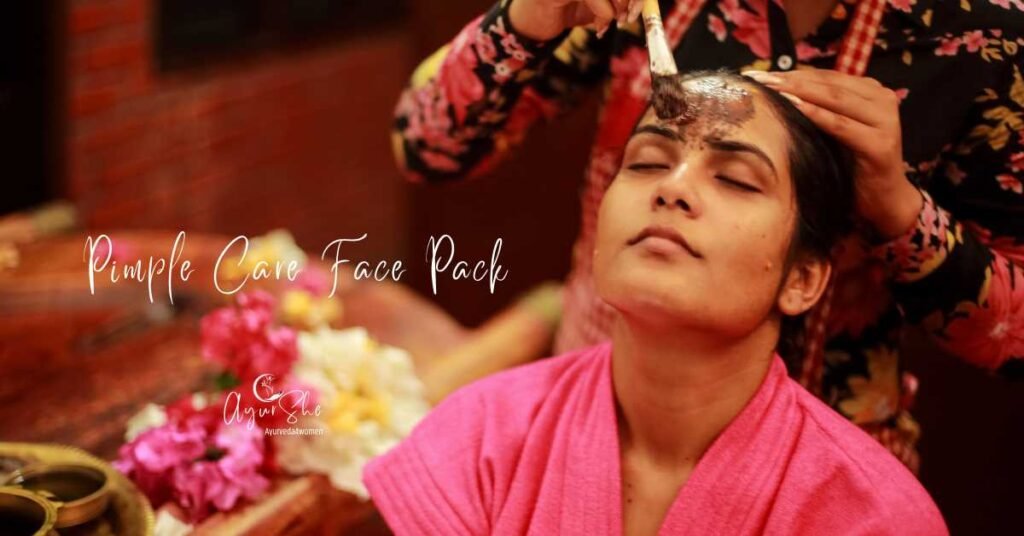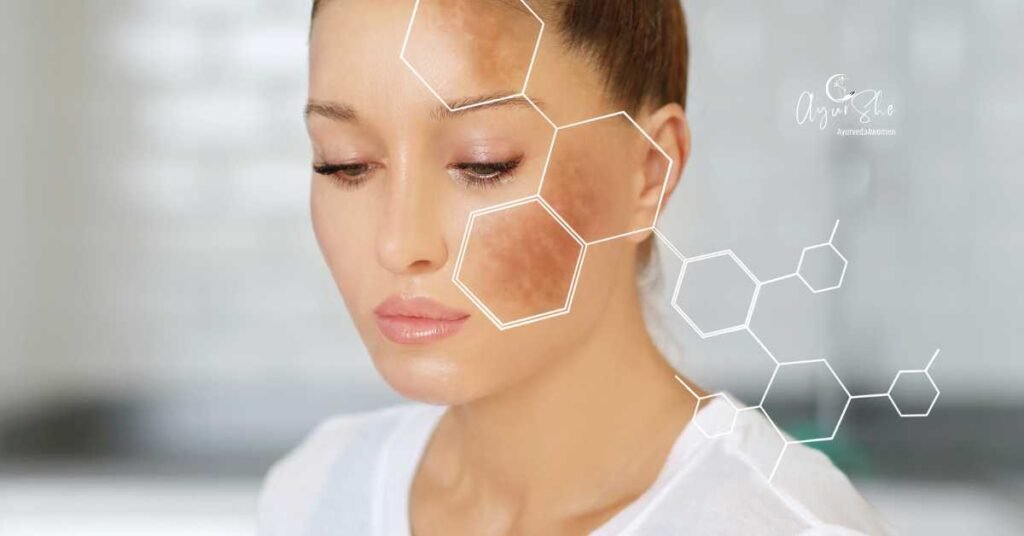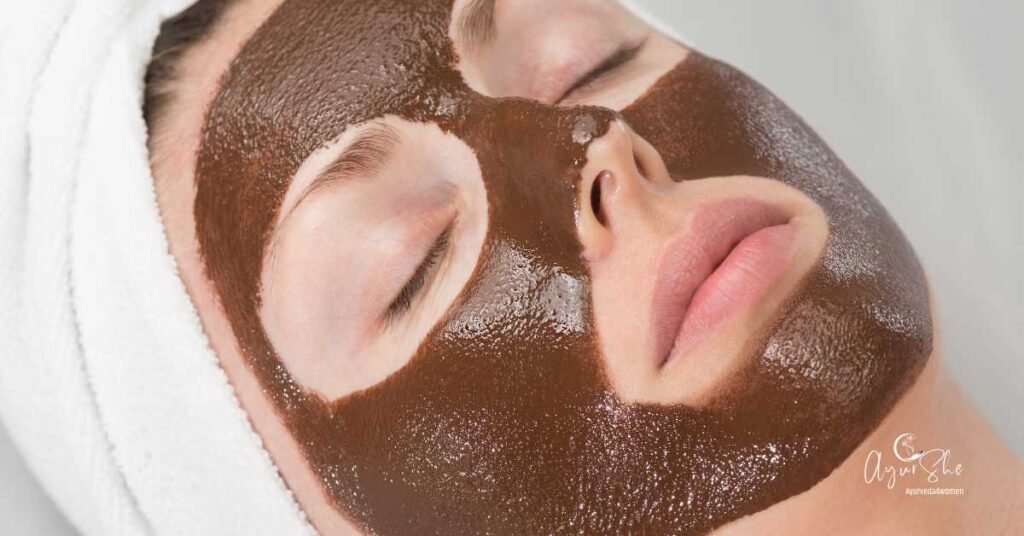Introduction
Melasma and post-inflammatory hyperpigmentation (PIH) are among the most frequent pigment concerns in women, especially in tropical climates and mid-to-dark Fitzpatrick skin types. Modern dermatology explains these conditions through melanocyte hyperactivity, hormonal triggers (e.g., pregnancy, oral contraceptives), UV/visible/IR light, heat, and inflammation (acne, procedures, eczema). Ayurveda reads a parallel story: Pitta aggravation (heat/inflammation), Rakta dushti (impure/overheated blood), and Ama with Srotorodha (micro-channel clogging) manifest on the skin as Vyanga/Neelika-type varna vikara (facial macules, blotchy color).
This guide gives you a step-by-step, do-able protocol that blends evidence-aligned skin science with authentic Ayurvedic care—including dosage and how-to-use for internal herbs and external applications—plus a maintenance plan to prevent relapse.
1) Know your pigment problem
Melasma
- Symmetric brown/gray-brown patches on cheeks, forehead, nose, upper lip, jawline.
- Deepened by sun/heat, pregnancy (chloasma), OCPs, thyroid issues.
- Epidermal vs dermal vs mixed (Wood’s lamp helps; mixed/dermal are tougher).
Post-Inflammatory Hyperpigmentation (PIH)
- Dark marks after acne, eczema, bites, procedures.
- More responsive than melasma if triggers are controlled.
Red flags → see a dermatologist first
- Rapidly changing, irregular solitary lesion; bleeding/ulceration.
- Pigment with hard borders + nodularity (rule out other dermatoses).
- Recurrent melasma with menstrual irregularities → evaluate hormones/thyroid.
2) Why pigment keeps coming back (the “four engines”)
- Light & Heat: UV and visible blue light stimulate melanocytes. Heat (sauna, hot yoga, steam) worsens melasma.
- Hormones: Estrogen/progesterone influence melanogenesis.
- Inflammation: Any redness → brown later (PIH).
- Barrier & Microbiome: Stripped barrier = more inflammation; dysbiosis increases reactivity.
Ayurvedic mirror: Pitta ↑ (heat/inflammation), Rakta dushti, Vata↑ (dryness → barrier fragility), Kapha-ama (stagnation, dullness).
3) The integrated plan—quick map
- AM: Cleanse → broad-spectrum sunscreen → light antioxidant/azelaic/niacinamide → hat/shade.
- PM: Cleanse → Ayurvedic lepa/serum (Manjistha, Yashtimadhu, Lodhra, Kumkumadi) → retinoid (2–3×/week) or glycolic/mandelic (1–2×/week).
- Inside-out: Rasayana + Pitta-Rakta pacifying herbs, cooling diet, gut reset.
- Monthly: Mild chemexfoliation (modern) or Varnya lepa + Mridu virechana cycles (Ayurveda) under supervision.
- Triggers: Heat avoidance, acne control, thyroid/hormone review if needed.
Details below (with dosages & how-to-use).
4) External care (Ayurvedic + Modern) — what to apply, when, how
A) Day defense (non-negotiable)
- Sunscreen (daily, 365 days)
- SPF 50+, PA++++, broad-spectrum UVA/UVB + visible light.
- How: 2-finger rule for face, reapply every 2–3 hours outdoors. Prefer tinted mineral (iron oxides) to block visible light—a melasma driver.
- Accessories: Wide-brim hat, sunglasses; avoid peak heat (10 am–3 pm).
- Under sunscreen (optional boosters)
- Azelaic acid 10% gel/cream AM (PIH/acne prone).
- Niacinamide 4–5% AM for barrier and pigment transfer control.
- Vitamin C (stable, low-irritant) if tolerated; otherwise use at night on non-retinoid days.
B) Night repair (rotate actives; go slow)
- Retinoid (tretinoin 0.025% cream or retinal/retinol)
- How: Pea-size, 2–3 nights/week, then build to 5 nights as tolerated. Buffer with moisturizer.
- Avoid during pregnancy/breastfeeding; consider bakuchiol alternative.
- AHA/BHA (prefer mandelic/glycolic 5–10%)
- How: 1–2×/week, alternate with retinoid nights.
- Over-exfoliation = rebound PIH; stay gentle.
C) Ayurvedic varnya lepa (complexion-enhancing packs)
Use 2–4×/week at night (non-retinoid nights). Patch test first.
- Manjistha–Lodhra Varnya Lepa (for melasma/PIH)
- Mix: Manjistha churna 1 tsp + Lodhra churna 1 tsp + rose water to paste.
- Apply thin layer to pigmented areas 10–12 min, rinse tepid water; moisturize.
- Yashtimadhu–Kesar Brightening Lepa (sensitive skin)
- Mix: Yashtimadhu (licorice) churna 1 tsp + milk/water; add a few threads of kesar (soaked).
- Apply 8–10 min; rinse. Licorice inhibits tyrosinase gently.
- Kumkumadi Tailam (serum use)
- How: After lepa nights or alone: 2–3 drops on damp skin, press-massage 60–90 sec; avoid heavy layer in acne-prone skin. 3–5 nights/week.
Tip: On lepa nights, skip acids/retinoid. Keep barrier happy: non-comedogenic moisturizer after wash.
5) Internal care (Ayurvedic herbs & formulations) — dosage & use
Adult general ranges; personalize with a vaidya if pregnant, lactating, on anticoagulants, or with hepatic/renal disease.
Core Pitta–Rakta pacifiers (anti-inflammatory, anti-melanogenic synergy)
- Manjistha (Rubia cordifolia)
- Dose: 500 mg capsule, BID after meals; or 1–3 g churna with warm water BID.
- Why: Rakta shodhana, reduces PIH/melasma tendency.
- Sariva (Hemidesmus indicus) or Usheer/Vetiver
- Dose: Sarivadyasava 15–20 ml with equal water BID after food or Ushirasava 15–20 ml BID.
- Why: Cooling, Pitta-Rakta pacifying; great for heat-triggered flares.
- Triphala (gentle gut detox; improves absorption)
- Dose: 1 tsp powder in warm water at bedtime (or 2 caps).
- Why: Clears ama; constipation worsens Pitta and PIH.
Antioxidant–Rasayana stack
- Amalaki (Emblica officinalis)
- Dose: 10–20 ml fresh juice AM empty stomach or 500 mg cap BID.
- Why: Vitamin C equivalent support, collagen, photoprotection.
- Guduchi (Tinospora cordifolia)
- Dose: 500 mg cap BID after meals.
- Why: Immunomodulation; calms subclinical inflammation that deepens pigment.
- Yashtimadhu (Glycyrrhiza glabra) (short courses)
- Dose: 250–500 mg cap BID, 6–8 weeks, monitor BP if hypertensive.
Classical combinations (practical)
- Khadradi or Sarivadyasava + Manjisthadi Kwath
- How: Asava 15–20 ml + equal water BID after meals; Manjisthadi kwath 20 ml BID before meals for 8–12 weeks in melasma with heat triggers.
- Avipattikar churna (Pitta down)
- Dose: 3 g in warm water HS if acid-peptic symptoms coexist.
Cycle: 8–12 weeks continuous → 2–4 weeks break → repeat if needed. Combine with topical plan and strict photoprotection.
6) Diet & lifestyle that actually lighten pigment (and keep it off)
Pitta-cooling, Rakta-cleansing plate
- Favor:
- Hydrating produce: cucumber, ash gourd, zucchini, tender coconut (room temp), pomegranate.
- Bitters & astringents: bottle gourd, ridge gourd, coriander, mint, tulsi water.
- Ghee (1–2 tsp/day) supports Agni without Pitta flare.
- Proteins with low inflammation: mung dal, sprouted legumes, paneer/curd at lunch, soaked almonds, sesame in moderation.
- Dial down/avoid (especially during flares):
- Chilies, pickles, fermented/sour excess, fried/ultra-processed, red meat; very hot beverages; late-night spicy dinners.
- Alcohol, smoking (vasodilation + oxidative stress).
- Hydration habit: 2–2.5 L/day; add coriander-fennel infusion (1 tsp each in 1 L water, simmer 5 min; sip).
Heat & light hygiene
- Avoid steam rooms/sauna/hot yoga if melasma prone.
- Kitchen/stove heat: use visor/fan; clean sunscreen re-application post-heat exposure when possible.
- Blue light: consider tinted sunscreen even indoors if near windows/screens.
Stress–sleep axis
- Yoga/Pranayama: Nadi Shodhana & Bhramari 10 min nightly; reduces cortisol-driven pigment flares.
- Sleep: 7–8 h; melatonin dysregulation worsens oxidative stress.
7) Panchakarma & in-clinic options (when to consider)
Ayurveda (under supervision):
- Mridu Virechana (gentle purgation) for high-Pitta phenotypes in seasonal cycles.
- Raktashodhana focus with Manjisthadi kwath, Sarivadyasava preceding/after gentle shodhana.
- Mukha abhyanga + Varnya lepa protocols weekly for barrier-safe brightening.
Modern dermatology (step-up, not first step):
- Topicals: Hydroquinone 2–4% (short cycles 8–12 weeks), azelaic 15–20%, kojic, arbutin, cysteamine, tretinoin.
- Oral TXA (tranexamic acid) for refractory melasma—only via dermatologist (thrombosis risk screening).
- Chemical peels: Mandelic/glycolic/jessner (low strength, spaced 3–4 weeks).
- Lasers: Use cautiously in darker skin; pre-prime with sunscreen + anti-inflammatory care; relapse common without maintenance.
8) 12-Week protocol (put it on your calendar)
Weeks 1–4 (Reset & Calm)
- AM: Gentle cleanse → Niacinamide or Azelaic 10% → Tinted mineral SPF 50+.
- PM: Gentle cleanse → Manjistha–Lodhra lepa (2–3×/week) → Kumkumadi 2–3 drops (on damp skin) → Moisturizer.
- Nights 2×/week: Retinoid (pea-size) instead of lepa; buffer.
- Internal: Manjistha 500 mg BID, Sarivadyasava 15–20 ml BID, Triphala HS.
- Diet: Pitta-cooling; coriander-fennel water.
Weeks 5–8 (Build & Brighten)
- Increase retinoid to 3–4×/week if tolerant.
- Keep lepa 2×/week. Introduce mandelic 5–10% 1×/week on a non-retinoid night.
- Add Amalaki 500 mg BID; continue Manjistha, Sarivadyasava.
Weeks 9–12 (Consolidate & Protect)
- Maintain daily SPF re-application, hats.
- Reduce actives if irritation; irritation = future PIH.
- Consider one gentle in-clinic peel or Mridu virechana if plateau, under expert care.
Maintenance (beyond 12 weeks)
- SPF forever.
- Retinoid 3–5 nights/week long-term; lepa 1–2×/week.
- Internal herbs 2–3 months on, 1 month off, repeat based on season/flares.
9) Safety notes & who should not experiment alone
- Pregnancy/Breastfeeding: Avoid retinoids, hydroquinone, oral TXA. Prefer azelaic, niacinamide, Kumkumadi minimal, sunscreens; internal herbs only with physician.
- Sensitive/eczema skin: Patch test all lepas/actives; barrier comes first.
- Hypertension/renal issues: Limit long licorice courses; monitor with clinician.
- Photosensitizing meds/procedures: Coordinate with dermatologist before peels/lasers.
10) FAQs (SEO boosters)
Q1. Can Ayurveda alone clear melasma?
Melasma is chronic/relapsing. Ayurveda plus strict photo/heat protection and gentle dermactives gives best odds. Expect control, not a permanent “cure.”
Q2. How long until I see change?
Epidermal pigment may lighten in 8–12 weeks; mixed/dermal needs 3–6 months and maintenance.
Q3. Is Kumkumadi safe for acne-prone skin?
Use 2–3 drops on damp skin, not heavy layers; alternate nights; stop if comedones increase. Pair with niacinamide/azelaic routines.
Q4. My pigment worsens every summer—what to do?
Begin Pitta-cooling herbs (Manjistha/Sariva) in late spring, switch to tinted mineral SPF, avoid sauna/steam, add hat + shade discipline.
Conclusion
Melasma and hyperpigmentation respond best to a quiet, consistent routine, not to aggressive quick fixes. Modern science asks you to block light and tame inflammation; Ayurveda adds Pitta–Rakta cooling, gut reset, and varnya nourishment so your skin barrier can stay calm and clear. With daily sunscreen, measured actives, and Manjistha–Sariva–Amalaki inside, most women can reach and hold their brightest, most even skin—without courting rebound pigmentation.




